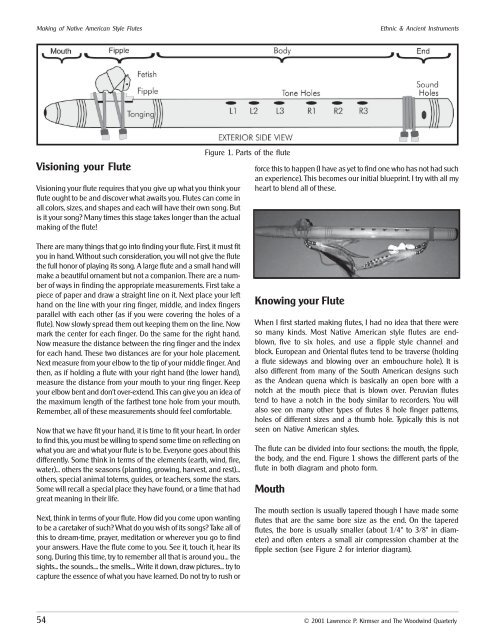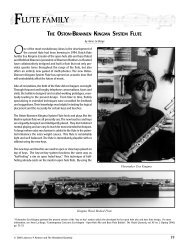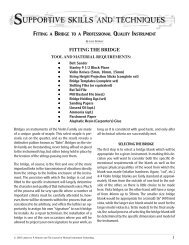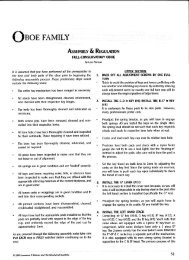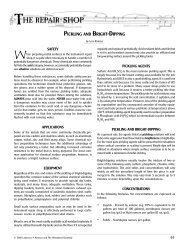The Native American Flute - Music Trader Index Page
The Native American Flute - Music Trader Index Page
The Native American Flute - Music Trader Index Page
You also want an ePaper? Increase the reach of your titles
YUMPU automatically turns print PDFs into web optimized ePapers that Google loves.
Making of <strong>Native</strong> <strong>American</strong> Style <strong>Flute</strong>s Ethnic & Ancient Instruments<br />
Visioning your <strong>Flute</strong><br />
Visioning your flute requires that you give up what you think your<br />
flute ought to be and discover what awaits you. <strong>Flute</strong>s can come in<br />
all colors, sizes, and shapes and each will have their own song. But<br />
is it your song? Many times this stage takes longer than the actual<br />
making of the flute!<br />
<strong>The</strong>re are many things that go into finding your flute. First, it must fit<br />
you in hand. Without such consideration, you will not give the flute<br />
the full honor of playing its song. A large flute and a small hand will<br />
make a beautiful ornament but not a companion. <strong>The</strong>re are a number<br />
of ways in finding the appropriate measurements. First take a<br />
piece of paper and draw a straight line on it. Next place your left<br />
hand on the line with your ring finger, middle, and index fingers<br />
parallel with each other (as if you were covering the holes of a<br />
flute). Now slowly spread them out keeping them on the line. Now<br />
mark the center for each finger. Do the same for the right hand.<br />
Now measure the distance between the ring finger and the index<br />
for each hand. <strong>The</strong>se two distances are for your hole placement.<br />
Next measure from your elbow to the tip of your middle finger. And<br />
then, as if holding a flute with your right hand (the lower hand),<br />
measure the distance from your mouth to your ring finger. Keep<br />
your elbow bent and don’t over-extend. This can give you an idea of<br />
the maximum length of the farthest tone hole from your mouth.<br />
Remember, all of these measurements should feel comfortable.<br />
Now that we have fit your hand, it is time to fit your heart. In order<br />
to find this, you must be willing to spend some time on reflecting on<br />
what you are and what your flute is to be. Everyone goes about this<br />
differently. Some think in terms of the elements (earth, wind, fire,<br />
water)... others the seasons (planting, growing, harvest, and rest)...<br />
others, special animal totems, guides, or teachers, some the stars.<br />
Some will recall a special place they have found, or a time that had<br />
great meaning in their life.<br />
Next, think in terms of your flute. How did you come upon wanting<br />
to be a caretaker of such? What do you wish of its songs? Take all of<br />
this to dream-time, prayer, meditation or wherever you go to find<br />
your answers. Have the flute come to you. See it, touch it, hear its<br />
song. During this time, try to remember all that is around you... the<br />
sights... the sounds.... the smells.... Write it down, draw pictures... try to<br />
capture the essence of what you have learned. Do not try to rush or<br />
Figure 1. Parts of the flute<br />
force this to happen (I have as yet to find one who has not had such<br />
an experience). This becomes our initial blueprint. I try with all my<br />
heart to blend all of these.<br />
Knowing your <strong>Flute</strong><br />
When I first started making flutes, I had no idea that there were<br />
so many kinds. Most <strong>Native</strong> <strong>American</strong> style flutes are endblown,<br />
five to six holes, and use a fipple style channel and<br />
block. European and Oriental flutes tend to be traverse (holding<br />
a flute sideways and blowing over an embouchure hole). It is<br />
also different from many of the South <strong>American</strong> designs such<br />
as the Andean quena which is basically an open bore with a<br />
notch at the mouth piece that is blown over. Peruvian flutes<br />
tend to have a notch in the body similar to recorders. You will<br />
also see on many other types of flutes 8 hole finger patterns,<br />
holes of different sizes and a thumb hole. Typically this is not<br />
seen on <strong>Native</strong> <strong>American</strong> styles.<br />
<strong>The</strong> flute can be divided into four sections: the mouth, the fipple,<br />
the body, and the end. Figure 1 shows the different parts of the<br />
flute in both diagram and photo form.<br />
Mouth<br />
<strong>The</strong> mouth section is usually tapered though I have made some<br />
flutes that are the same bore size as the end. On the tapered<br />
flutes, the bore is usually smaller (about 1/4" to 3/8" in diameter)<br />
and often enters a small air compression chamber at the<br />
fipple section (see Figure 2 for interior diagram).<br />
54 © 2001 Lawrence P. Kirmser and <strong>The</strong> Woodwind Quarterly


